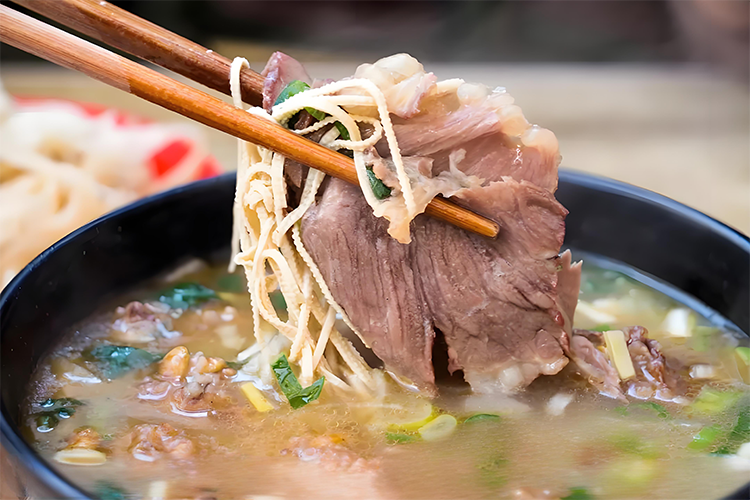Luoyang Donkey Soup: Imperial Breakfast Delight
1. Origin and History
Luoyang donkey soup traces its roots to the Ming dynasty, when palace chefs developed restorative dishes for the imperial court. Donkey meat was prized for being high in protein and low in fat; cooks combined donkey bones and meat with warming spices to create a nutritious, flavorful broth. Over centuries this royal recipe migrated from palace kitchens into Luoyang’s streets, where local chefs adapted it to everyday tastes and turned it into an accessible regional specialty within Henan cuisine.
2. Cultural Significance
In Luoyang, soup is a daily cultural habit and donkey soup is a local emblem. Residents often start their day at small, family-run soup shops. Drinking donkey soup is a communal ritual that reflects the city’s practical, unpretentious food culture — nourishing, honest, and rooted in tradition. For visitors, sipping this soup is a quick, authentic way to connect with local life and the city’s long culinary lineage.

3. Key Ingredients and What Makes It Special
The soul of Luoyang donkey soup is quality ingredients and careful selection:
- Donkey bones and meat: Typically from adult donkeys of a certain age for optimal tenderness and collagen, the bones yield the gelatinous, milky stock when simmered long.
- Aromatic spice bundle: A tightly guarded mix often includes star anise, cinnamon, clove, sand ginger, and other warming spices that remove any gaminess and deepen the broth.
- Fresh aromatics: Chopped scallions and cilantro are added at service to brighten and lift the rich broth.
Combined, these elements produce a savory, clean, and layered broth with tender slices of meat.
4. The Traditional Preparation Process
Making authentic Luoyang donkey soup is a slow, patient process:
- Clean and crack the donkey bones, blanch to remove impurities, and rinse well.
- Boil bones and water to start, skimming foam for clarity; then add the sealed spice bundle.
- Simmer gently for many hours — often overnight — until the stock turns a silky, milky white as collagen and marrow dissolve into the liquid.
- Simmer meat separately until tender, then slice thinly before serving.
This long-simmer technique is why the broth tastes concentrated, rich, and silky.

5. Flavor and Texture
Luoyang donkey soup offers a complex yet balanced sensory experience: an immediate fragrant aroma, followed by a savory, deep umami “freshness” from prolonged simmering. The broth is smooth and slightly gelatinous, while the meat slices are tender and delicate. Spices are subtle partners, enhancing rather than overpowering the natural flavor of the marrow-rich stock.
6. How to Eat It: Local Etiquette and Pairings
Local shops typically offer two basic options: “sweet soup” (unsalted, to taste the pure broth) and “salty soup” (pre-seasoned). Many locals start with a bowl of sweet soup to appreciate the unadulterated stock, then add salt, chili oil, or vinegar to taste. The classic accompaniment is bing si — thin strips of layered pancake (or crumbled baked flatbread) placed into the hot soup to soak up the broth. Order a side of bing si for the full, traditional experience. Locals may also pair the bowl with a local soda or tea to refresh the palate.

7. Tasting Tips for Travelers
- Best time: Early morning to midday. Many authentic stalls sell out by afternoon.
- Shop selection: Choose busy, local-frequented shops rather than tourist-focused restaurants for the truest flavors.
- Taste test: Try an unsalted bowl first, then add condiments gradually to discover preferred balance.
- Portion check: Ask for meat portion sizes (shops often price by meat amount) and whether bing si is included.
8. Practical Tourist Advice
- Lines: Popular shops can form queues — arrive early to avoid waits and to taste the fresh morning batch.
- Allergies/diet: Donkey meat is red meat; those with dietary restrictions should plan accordingly.
- Payments: Many small shops accept only cash or local mobile pay — have small bills ready.
- Language: Bring a simple phrase or photo of / donkey soup” to help ordering if you don’t speak Chinese.

9. Easy Home Version for Travelers
You can approximate Luoyang donkey soup at home if donkey meat is available locally. A simplified method:
- Ingredients: donkey bones and meat (or substitute with beef bones if necessary), scallions, ginger, cooking wine, and a spice bundle (star anise, cinnamon stick, cloves, bay leaf).
- Steps:
- Blanch bones and meat, rinse, then simmer bones with spice bundle for 3–6 hours (longer gives more body).
- Simmer meat separately until tender; slice thin.
- Strain the broth, reheat, combine with meat slices, garnish with scallions and cilantro. Serve with thin pancake strips or toasted flatbread.
While the home version won’t fully reproduce an authentic Luoyang overnight simmer, it yields a comforting, richly flavored soup that recalls the original.
10. Conclusion
A bowl of Luoyang donkey soup condenses centuries of culinary care into a simple, restorative meal. For travelers in Henan, it’s a must-try: historically rich, culturally meaningful, and deeply satisfying. Wake up early, find a busy local stall, and let this imperial-origin broth be the savory start to your Luoyang adventure.


